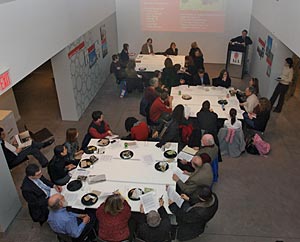When unveiled a few months ago, the federal economic stimulus bill tantalizingly hinted at heaps of jobs for architects building schools and retrofitting federal buildings to make them more energy efficient.
The $787 billion version that ultimately became law in mid-February, though, had fewer opportunities for design professionals, at least explicitly, as lawmakers had pared it along the way to garner support. Specifically, school construction-aid was removed from the final bill.
Ideas for how the federal government can help create work for architects have been discussed during recent forums at the Center for Architecture in New York. The forums are part of a series of events, dubbed Not Business as Usual.
In the near future, the construction industry is more likely to benefit from the stimulus package than the design profession, suggests Rick Bell, executive director of the New York chapter of the American Institute of Architects. “But there will be opportunities for architects in the wake of these projects,” says Bell, singling out bridge, roadway, and mass-transit projects. “It’s a good start.”
In the meantime, there may be other ways that the federal government can help create paying jobs for out-of-work architects. A few ideas have been kicking around since December, when they were introduced at a roundtable at the Center for Architecture in New York. The forum was part of a series of events, dubbed Not Business as Usual, geared toward helping architects during these troubled times.
BIM Database
The government could hire architects to catalogue federal buildings with cutting-edge building information modeling, or BIM, an idea put forth by Paul Seletsky, director of digital design for the New York office of Skidmore, Owings and Merrill.
The BIM database concept is similar to the ongoing Historic American Buildings Survey, launched in 1933 and overseen by the National Park Service. While HABS is fairly limited to line drawings and photographs, the data-rich BIM models would meticulously assess features like layouts, roofs, and cladding, which could come in handy in the event of a fire or security breach, says Seletsky.
If, for instance, terrorists attacked the Supreme Court in Washington, D.C., SWAT teams could quickly tap into the digital model to figure how to navigate the court’s warren of chambers. “There will no scrambling in an emergency to see who has the floor plans,” Seletsky explains.
Energy Audits
The federal government could also launch a sweeping energy audit of existing federal buildings, Bell explains.
Classifying the types of windows, doors, and insulation found in airports, federal agencies, and public museums could go a long way toward figuring out how much heat and cool air they retain. Moreover, information gleaned from these audits could help landlords make informed purchasing decisions. When it came time to replace a window, for instance, they could easily assess which type is better: a single-glazed model or a more eco-friendly version with two glass sheets.
“Energy surveys aren’t rocket science,” Bell says. “But they could still put tens of thousands of architects to work.”
Design Corps
A third option being bandied about is the creation of a “Design Corps” to undertake public construction projects in the spirit of the Great Depression’s Works Progress Administration.
It could be folded into the AmeriCorps program, which will be tripled in size under the stimulus package, from 75,000 to 225,000 positions. Ideally, 10 percent of those jobs would go to architects, says Maurice Cox, design director for the National Endowment for the Arts. Cox has been a chief proponent of the Design Corps idea.
What type of work could architects perform? In the case of building affordable housing, for instance, designers could help ensure homes are sturdy, stylish, and environmentally friendly, Cox says. “It’s about raising the bar on design excellence,” he says, “and insuring that the larger agenda of greening our national infrastructure is threaded throughout all the projects.”
The federal program would be similar in spirit to the Raleigh-based Design Corps, a nonprofit that provides architecture and planning services to communities in need. The organization pays fellows—typically recent graduates—a modest stipend to carry out the work. The federal Design Corps program could potentially offer full salaries, advocates say.
Read more economic news, including stories related to the federal stimulus plan, in our Recession and Recovery special section.



Post a comment to this article
Report Abusive Comment